ABOUT THE HEADER
The EcoVolt team from Instituto Tecnológico y de Estudios Superiores de Monterrey (Tec) was one of 70 teams from across the Americas. Incidentally, SwRI recently entered into a collaborative agreement with Tec to jointly fund research and development initiatives to advance sustainable manufacturing and technology in the United States and Mexico.
As the U.S. and other countries around the world aim for netzero greenhouse gas (GHG) economies by 2050, decarbonizing the transportation sector will play a critical role in addressing climate change and protecting human health and the environment. Transportation is the largest source of GHG emissions in the U.S., which are 97% carbon dioxide.
The transportation sector needs to eliminate nearly all GHG emissions using a holistic strategy to create a clean, safe, secure, accessible and affordable mobility system with sustainable transportation options for people and goods.1
For a little over 10 years, Southwest Research Institute (SwRI) has served as a Shell Eco-Marathon (SEM) sponsor, providing science, technology, engineering and math (STEM) outreach as well as evaluation of the latest efficient and automated driving technologies. These annual engineering competitions challenge hundreds of student teams from around the globe to design, build, test and drive ultra-energy-efficient vehicles. SwRI staff provide technical and engineering support and present one student team with an award recognizing innovation.
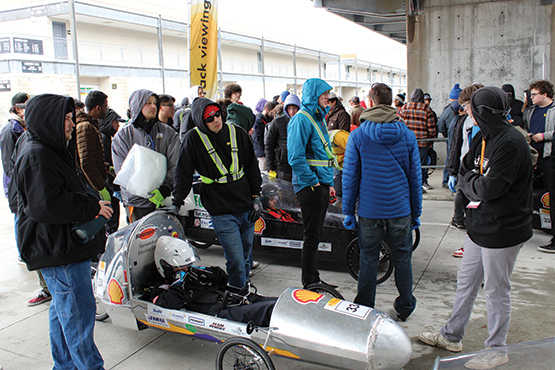
Teams queue up at the Indianapolis Motor Speedway track entrance in anticipation of the first day of the Shell Eco-Marathon Americas competition.
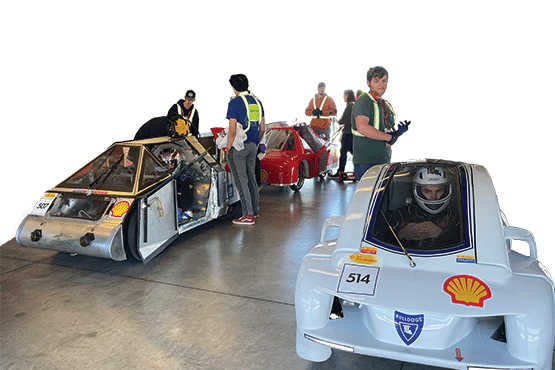
Teams from across North and South America developed urban concept vehicles (typically four-wheeled) and prototype ultra-efficient lightweight vehicles (usually three-wheeled) powered by three engine categories for the SEM Americas competition. These vehicles include internal combustion engines (ICEs) — powered by gasoline, diesel, ethanol or compressed natural gas — as well as hydrogen fuel cells and battery-electric vehicles (BEVs).
"We’ve seen a lot of first-time competitors and a lot of first-time designs. Seeing the students’ excitement when their hard work has paid off, they have passed their tech and safety inspections, and they realize their vehicle will make it to the track. Even if they don’t win, just passing and getting out there brings the teams immense joy. Experiencing that alongside the students has been tremendously rewarding."
— Jose Starling, senior research engineer in SwRI’s Fuels and Lubricants Research Division, who focused on pre-competition inspections.
SEM shares many of the same sustainability goals and has a similar philanthropic mission as SwRI, which focuses its outreach activities on STEM programs. SEM events provide the next generation of engineers and scientists around the world with the opportunity to collaborate as teams and explore current and future vehicles and energy that will shape a lower carbon future for all.
As one of the largest independent engine, fuel and lubricant research and development organizations in the world, SwRI is well-positioned to provide the SEM teams with the support they need to compete. Plus, using more than 20 years of experience developing automated driving solutions, the Institute is developing techniques to reduce vehicular energy consumption using next-generation connected and automated driving technology.

From left, SwRI staff member Logan Elliott and consultant Joe Redfield check Kankakee Valley High School’s urban concept internal combustion engine vehicle before an attempted run.
SwRI staff recently participated in the 2024 SEM Americas, held in April at the Indianapolis Motor Speedway (IMS), and the 2024 SEM Europe-Africa competition in Nogaro, France, held in May. Thousands of students participate in SEM events each year gaining valuable STEM knowledge and hands-on experience. This year SEM is also featuring regional events for students from the Asia-Pacific and Middle East, Brazil and China, along with an Autonomous Urban Concept Competition that took place concurrently with the Europe and Africa event. SwRI has a presence at nearly every eco-marathon in some way.
The competition recognizes two different car types — urban concept vehicles, which are typically four-wheeled, and prototype ultra-efficient lightweight vehicles, which are usually three-wheeled. Teams can choose between three engine categories, including internal combustion engines (ICEs) powered by gasoline, diesel, ethanol or compressed natural gas. The other platforms are battery-electric vehicles (BEVs), powered by hydrogen or lithium, and hydrogen fuel cell vehicles. 2024 SEMs will host three big regional events. These “supermileage” events allow experienced teams to push new boundaries, encouraging innovation and novel approaches to achieving energy efficiency.
SEM Americas
On a cold, wet and windy April morning, hundreds of high school and college students from across North and South America bundled up in heavy jackets, scarves and beanies at the famous Indianapolis venue to begin the multiday competition.

SwRI’s Jared Cavaliere (second from left) collaborates with a Shell employee, reviewing the Escudería EcoVolt team’s prototype BEV.
In dozens of paddocks just off the track, teams of up to 15 student engineers work rapidly and intently, preparing the ultra-energy-efficient vehicles transported from across the Western Hemisphere. Some of the vehicles resemble a single rider coupe, while other, more experimental designs evoke submarines or jet cockpits. The teams have painstakingly designed and built their vehicles for the opportunity to complete the 2.5-mile-long track and prove their design is the most energy-efficient vehicle in Indianapolis this year. Before their car can even make it onto the track, it must pass rigorous technical and safety evaluations conducted by SwRI and Shell.
"It’s been hard. During travel, part of our frame cracked, and it’s not a spot fix. It’s a take-everything-apart-and-fix-that-one-thing problem to put it back together. We were working all the 12 hours we were allowed to be in the paddock and trying to get it ready for the inspection to just pass with two minutes left in the inspection … but we’re a strong team with a lot of determination and perseverance."
— Siobhan Scott, team manager from the University of Manitoba, Canada, racing a BEV prototype.
SwRI staff from the Fuels and Lubricants Research and Intelligent Systems divisions work alongside Shell staff to ensure the proceedings run safely and smoothly. In a row of garages adjacent to the famous IMS track, SwRI and Shell staff members mentor students, testing each vehicle and evaluating everything from electrical and fuel systems to brakes and seat belts. The requirements are so rigorous that teams that have spent months working on their vehicles may falter at the inspections. Many teams have the simple goal of passing the inspection.
For instance, safety feature and vehicle design inspections verified that drivers could exit the vehicles easily and safely and that seatbelts are properly installed. Students would be prompted to complete mock-emergency evacuations of their vehicles within a certain time limit. Interiors were examined for potential hazards.
In 2024, more than 70 teams including 750 students from five countries participated in the SEM Americas regional event, competing in on-track categories representing different fuel and design philosophies. The goal of the competition is to inspire students to experiment with different energy solutions, challenging them to travel the longest distance using as little energy as possible. Each vehicle and engine category has its own requirements that must be met to attempt a run around the track.

SwRI’s Michael Moneer (left) and Jose Starling (right) conduct an interior safety check of the University of Manitoba’s EcoMotion prototype BEV.
Over the course of each competition day, students pull their vehicles from the paddock to the inspection garages, lining up for evaluation. Then they either move onto the track to attempt a run or haul them back to their paddock for last-minute improvements. Teams have up to six run attempts with their energy use (mi/kWh) recorded on scoreboard monitors around IMS. Their best completed attempt determines their place in the competition. Countless factors can make or break a run, from the weather to a miscalculated turn to overzealous acceleration. At SEM, efficiency, not speed, is the most important factor in the race.
For the teams, every second, every move, every mechanical function, and every bit of expended energy on the track could be the difference between leaving IMS with a win or not. During runs, students often dress in team uniforms, peering through binoculars from the stands and offering drivers potential efficiency hints via walkie talkie. At times, cars on the track stall out and are towed to their paddocks. Then the work begins anew to troubleshoot and fix the cause of a failed run before trying again. Difficulties can crop up during any stage of the competition, and students are challenged to find solutions.
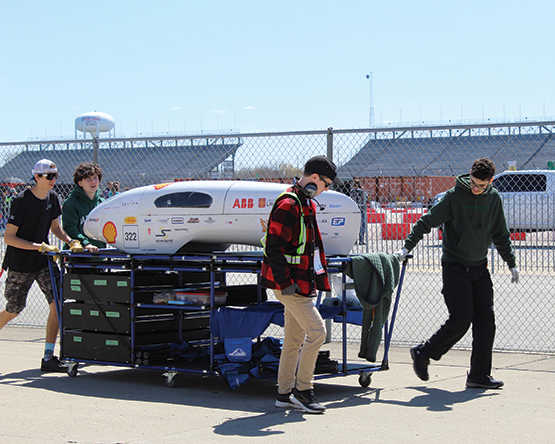
Students from the Alérion supermileage team with Université Laval in Canada haul their prototype BEV to the test track for inspection. Their team placed third in their category with a best attempt of 197.28 mi/kWh.
"It’s a once-in-a-lifetime experience ... How many kids can say they drove a vehicle around IMS or Sonoma? I don’t think we’ve had any negative feedback. It’s very reassuring to the students who’ve put all their time, blood, sweat and tears into it. It’s been an exciting, transformative experience."
— David Hass, an advisor for the Kankakee Valley High School team, which placed second overall in their category
By the third day of SEM Americas, teams have settled into a groove. Teams can work and race up to 12 hours a day. In the evening, many teams camp out at IMS. Several teams have been here before and are already planning to come back in 2025, but for others, this is one of the few opportunities that they have as students to get this kind of hands-on STEM experience.
SEM Americas ends with a regional championship race between the top-scoring urban concept vehicles from each energy category. This year, six teams — five high school teams, including Kankakee Valley High School, and one university team, the University of Ottawa, competed in the finals, with the challenge to complete four laps on a set amount of fuel/energy. The combination of starting position and energy usage efficiency determines the winner of the race.
The Gold Warriors Team from Wawasee High School in Syracuse, Ind., and their gasoline internal combustion engine vehicle finished with the gold this year. All but one team completed the four laps to cross the finish line.
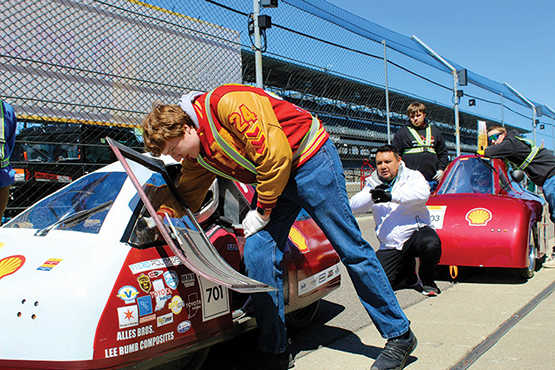
SwRI’s Jose Starling (in white) checks the urban concept BEV designed and built by Team RUDI from Mater Dei High School. Team RUDI placed first in their category reaching an efficiency of 120.38 mi/kWh.
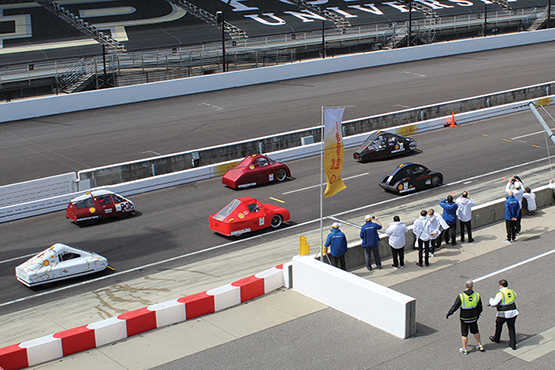
Six vehicles, designed by high schools in Minnesota and Indiana as well as the University of Ottawa, competed in the SEM Americas urban concept vehicle race on Sunday, April 7.
SwRI vice presidents Steve Marty, Dr. Steve Dellenback and Tony Magaro participated in the event to share information about SwRI with interested students and select the winning team for the SwRI-sponsored award. Marty and Dellenback interviewed 10 teams, including a team that focused on increasing engine performance and reducing emissions immediately after engine start-up addressing these high transient emissions associated with cold starts.
In the process of selecting the Technical Innovation Award winner, SwRI saw first-hand the students’ ingenuity and problemsolving skills at work. Transient-based emissions are extremely relevant for current low-emissions goals with real-world applicability for solving today’s problems, and students were applying this for a race/mileage advantage.
SwRI presented the Off-Track Technical Innovation Award to the supermileage entry from Brigham Young University.
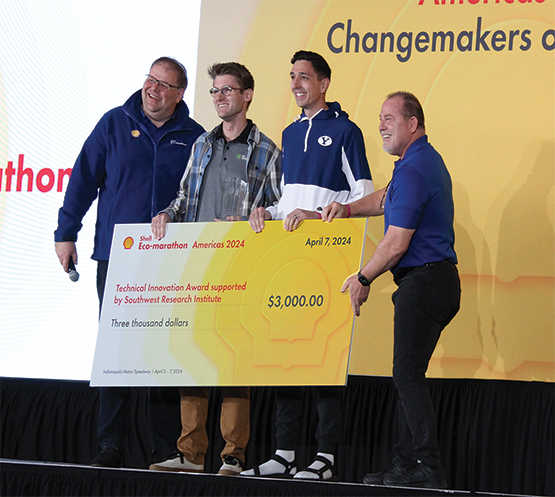
SwRI Vice President Steve Marty (right) presents the Technical Innovation Award to the leaders of the Brigham Young University team.
"Students in this year’s autonomous urban concept
competition made significant strides in their cars. For
the first time, a team completed all stages of the test
track and did so using only cameras and lidar,
without any GPS guidance at all. All the teams made
it much farther in the course than they had in the
previous years, demonstrating sophisticated autonomy
and machine learning algorithms. SwRI staff had a
great time judging the contest and talking with the
students about their hard work."
— Dr. David Anthony, a lead engineer in SwRI’s Intelligent
Systems Division, who took part in vehicle inspections
as well as the automated driving competition
SEM Europe/Africa
The SEM Europe/Africa competition was held May 19–24 in Nogaro, France, home of Circuit Paul Armagnac, a motorsport racetrack in southwestern France. Over 300 student teams participated in the vehicle efficiency marathon. The Europe-Africa event also included an autonomous urban concept competition.
In addition to providing technical team support for the high-mileage competition similar to the SEM Americas, SwRI provided technical support and guidance for the automated system competition held prior to the superhigh- mileage challenge. Of the six teams that submitted entries, five teams successfully passed their technical inspections and moved onto the track for competition.
The competition consisted of three automation challenges that must be completed without driver intervention. First, vehicles must traverse multiple corners of the F-1 track over a distance of approximately 1 kilometer. Then entries must complete an obstacle course, which requires vehicles to take a circuitous route to complete the challenge. And finally, each vehicle must identify which of the three parking places is vacant and park itself within the lines. After the driving competition, each team made a business presentation and was judged on its technical approach to solving the challenges. SwRI’s Intelligent Systems Division provided Shell with input and planning assistance based on almost 20 years of experience in developing automated driving solutions.
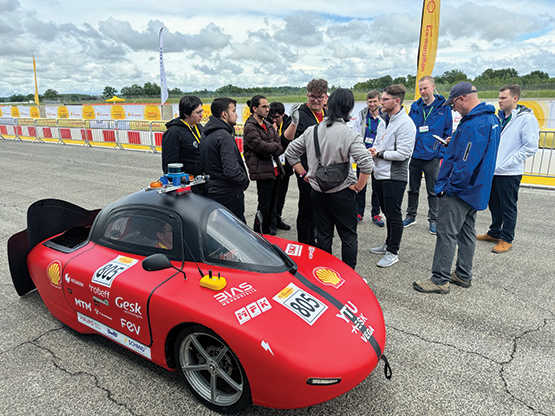
A team from Yildiz Technical University (YTU) in Instanbul, Turkey, prepares their automated driving entry for three challenges that must be completed without driver intervention, including track driving, an obstacle course and parking. From right, SwRI’s Dan Engstrom, David Anthony, Shell’s Melle de Wit and SwRI’s Logan Elliott advise the YTU team.
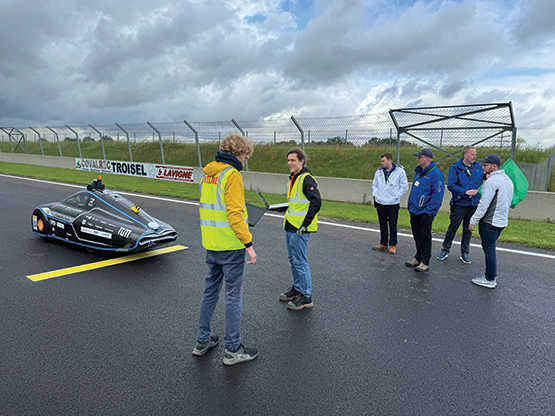
In the background, from left, SwRI’s Dan Engstrom, David Anthony and (right) Logan Elliott worked alongside Shell’s Melle de Wit (second from right) to certify that this automated driving concept car was cleared to compete. A team from the Technical University of Munich, one of Germany’s leading universities for research and teaching in natural sciences and engineering, developed this novel vehicle.
Taking part in SEM is just one facet of SwRI’s commitment to STEM outreach. The Institute also collaborates with Shell in providing an eco-marathon internship program for junior and senior university engineering students. Interns work alongside SwRI engineers on projects tackling current and future mobility technologies. SwRI also has STEM outreach programs in engineering and robotics that it has supported for more than 30 years.
Challenging the next generation of engineers and scientists — who will tackle the problems where the current generation leaves off — is crucial. For instance, SwRI’s automated driving system program was inspired, in part, by new staff members who took part in DARPA’s automated driving challenges as students. Inspiring and equipping the next generation is critical to meeting net-zero emissions goals.
Questions about this story or Automotive? Contact Steven Marty at +1 210 522 5929 or Dr. Steve Dellenback, at +1 210 522 3914.
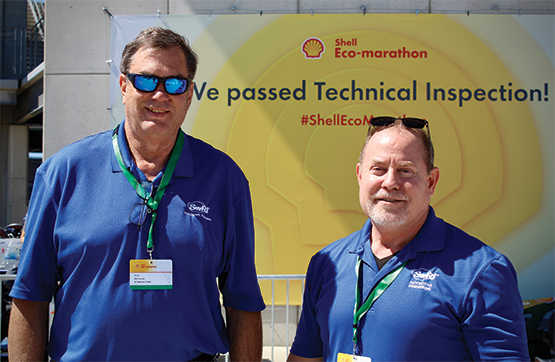
ABOUT THE AUTHORS
Steven Marty (right), vice president of SwRI’s Fuels and Lubricants Research Division, brings automotive specialists to support the safety and technical evaluations of the student developed ultra-energy-efficient vehicles participating in the Shell Eco-Marathon. Dr. Steve Dellenback, vice president of the Intelligent Systems Division, brings connected and automated vehicle specialists to lend their expertise to the pre-race inspections as well as the automated driving competition held in France.

